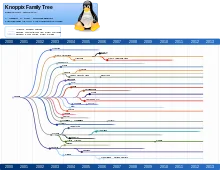
CentOS is one of the most popular server distributions in the world. It is an open-source fork of Red Hat Enterprise Linux (RHEL) and offers the benefits of RHEL without the costs associated with RHEL.
However, things have changed lately. Red Hat is transitioning the stable CentOS to a rolling release model in the form of CentOS Stream. CentOS 8 was supposed to be supported until 2029, but is now being phased out by the end of 2021.
If you’re using CentOS for your servers, you might be wondering where to go from here.
See, the first choice to replace CentOS 8 is CentOS Stream. the The process to upgrade from CentOS 8 to CentOS Stream is simpleand you don’t have to worry about reinstalling here.
However, since CentOS Stream is a rolling release, consider something more stable for a production server. I will help you with this decision by proposing some recommendations in this article.
RHEL-based server Linux distributions that you may want to consider replacing CentOS
I’ll start the list with some of the RHEL forks intended to replace CentOS 8. I’ll also list some server distributions that aren’t exactly RHEL forks, but should prove useful.
Rocking Linux
![]()
On the same day that Red Hat announced its plans to replace the stable CentOS 8 with the rolling release CentOS Stream, the original developer of CentOS announced a new project to provide CentOS users with a RHEL fork.
This new project is called Rocking Linux. It’s named in memory of one of the co-creators of the original CentOS project. It was forked from RHEL 8 and is said to be “100% bug-for-bug compatible with Red Hat Enterprise Linux”.
It offers easy migration, is supported by the community and acts as a downstream to RHEL. So this is one of the obvious ways to replace CentOS.
AlmaLinux operating system
![]()
” data-medium-file=”https://i0.wp.com/itsfoss.com/wp-content/uploads/2021/12/almalinux.png?fit=300%2C207&ssl=1″ data-large-file=”https://i0.wp.com/itsfoss.com/wp-content/uploads/2021/12/almalinux.png?fit=624%2C430&ssl=1″ loading=”lazy” width=”624″ height=”430″ src=”https://i0.wp.com/itsfoss.com/wp-content/uploads/2021/12/almalinux.png?resize=624%2C430&ssl=1″ alt=”almalinux” class=”wp-image-94847 jetpack-lazy-image” data-recalc-dims=”1″ data-lazy- data-lazy-src=”http://a.codepre.com/s3/wp-content/uploads/sites/5/2022/03/almalinux.png”>
AlmaLinux (originally known as Project Lenix) is a CentOS alternative supported by the team behind CloudLinux OS.
Although it is an initiative of a well-known organization, with its help it adopts the same principle of building for the community.
The team behind AlmaLinux is an enterprise-oriented service that has been providing custom CentOS servers for several years. Therefore, their experience with AlmaLinux OS should reflect and give you confidence to choose AlmaLinux for your servers.
Oracle Linux
![]()
Probably the only RHEL fork in this list that is as ready to use as possible. Not only ready to use, but you can do it yourself migrate from an existing CentOS installation to Oracle Linux without reinstalling it.
Oracle Linux has been available since 2006. It is 100% application binary compatible with Red Hat Enterprise Linux (RHEL) and provides an equivalent to any RHEL version. And no, you don’t have to sign a contract with Oracle to use Oracle Linux.
Oracle Linux ships with two different Linux kernels: the Unbreakable Enterprise Kernel (UEK) for Oracle Linux or the Red Hat Compatible Kernel (RHCK).
It’s just that Oracle’s track record of open source projects isn’t very good, and that’s probably why a true community fork in the form of CentOS was preferred to Oracle Linux. With CentOS being replaced by CentOS Stream, maybe it’s the right time to give Oracle a shot?
ClearOS (by HP)
![]()
ClearOS is offered by HP on its HPE ProLiant servers. Although not clearly mentioned on their website, ClearOS is based on RHEL and CentOS.
Delete middle and HPE have joined forces on this project. The open source ClearOS is available to the community free of charge. They have their app marketplace with a mix of free and paid apps. You don’t pay for the operating system, but you might have to pay for the apps if you opt for a paid one.
It may not be as popular, but with CentOS Stream becoming the standard, ClearOS will gain some user base if HP plays its cards right. will they do it I am not sure. Oracle is trying to lure CentOS users, but I haven’t seen any such effort from HP.
Springdale Linux (Princeton University academic project)
![]()
” data-medium-file=”https://i0.wp.com/itsfoss.com/wp-content/uploads/2020/12/springdale-linux.png?fit=300%2C131&ssl=1″ data-large-file=”https://i0.wp.com/itsfoss.com/wp-content/uploads/2020/12/springdale-linux.png?fit=800%2C350&ssl=1″ loading=”lazy” width=”800″ height=”350″ src=”https://i0.wp.com/itsfoss.com/wp-content/uploads/2020/12/springdale-linux.png?resize=800%2C350&ssl=1″ alt=”Springdale Linux” class=”wp-image-85947 jetpack-lazy-image” data-recalc-dims=”1″ data-lazy- data-lazy-src=”http://a.codepre.com/s3/wp-content/uploads/sites/5/2022/03/springdale-linux.png”>
A Red Hat fork maintained by academics? That’s Scientific Linux, right? But Scientific Linux has been dead for over a year.
Springdale Linux (SDL) is another such project from Princeton University. It was formerly known as PUIAS (Princeton University Institute for Advanced Study).
There is no RHEL 8 equivalent to Springdale Linux yet, which gives an indication of the speed of development here.
Server distributions not based on Red Hat
Alright! So far the list mentions the Red Hat based distributions. It’s time to look at some of the server distributions that are unrelated to RHEL but are still good choices for your production server.
YunoHost (Specially adapted for web servers)
![]()
” data-medium-file=”https://i0.wp.com/itsfoss.com/wp-content/uploads/2020/12/yunohost.png?fit=300%2C167&ssl=1″ data-large-file=”https://i0.wp.com/itsfoss.com/wp-content/uploads/2020/12/yunohost.png?fit=720%2C400&ssl=1″ loading=”lazy” width=”720″ height=”400″ src=”https://i0.wp.com/itsfoss.com/wp-content/uploads/2020/12/yunohost.png?resize=720%2C400&ssl=1″ alt=”Yunohost” class=”wp-image-85948 jetpack-lazy-image” data-recalc-dims=”1″ data-lazy- data-lazy-src=”http://a.codepre.com/s3/wp-content/uploads/sites/5/2022/03/yunohost.png”>
You can use it on ARM boards like Raspberry Pi, old desktops and computers on virtual private servers.









